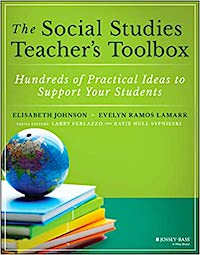How-to Social Studies: A Book for Right Now
The Social Studies Teacher’s Toolbox: Hundreds of Practical Ideas to Support Your Students
By Elisabeth Johnson and Evelyn Ramos Lamarr; series editors Larry Ferlazzo and Katie Hull Sypnieski
(Wiley/Jossey-Bass, 2020 – Learn more)

Why care about the teaching of social studies? As teachers scramble to meet math and literacy standards, our intermediate students (my specialty) often miss valuable teaching time that should allotted to the social studies curriculum.
This is a mistake. Our intermediate and secondary students need a high-quality social studies curriculum to be able to “make sense of the world” – and never more than right now.
It is critical that the education we provide for our learners helps them to become informed and reasoned decision makers. It is also critical that our students develop the critical thinking skills that will help them make the best decisions.

Elizabeth Johnson and Evelyn Ramos Lamarr are educators who have spent countless hours researching theory and lesson plans to provide other teachers with a toolkit that they can use.
Their book comes complete with lessons which will engage students, inspiring them to learn more, challenging their thinking, and preparing them to become responsible citizens of the twenty-first century.
Research based lessons
As I previewed the book, I was astounded by the amount of work that went into publishing this valuable resource. Each of the research-based lesson plans (and there are many in this 466-page book) was relevant, was research based, and promoted the kind of investigation and inquiry that assures students will broaden their understanding of themselves and the world.
The book is divided into four sections:
- strategies to support reading and writing in social studies
- a section on analytical tools
- strategies for speaking and listening
- additional key strategies to apply in the classroom
Each chapter delves into the “who, what, where, why, how” of applying the specific strategy in your social studies classroom, including:
- a description of the strategy and useful application (from the authors’ experience),
- research for the effectiveness of the strategy along with NCSS Curriculum Standards,
- in-depth ideas on how to apply the strategy,
- differentiation ideas,
- ways to provide extra challenges for students,
- common mistakes, and
- technology connections.
I was impressed with the breadth and depth of the topics within this resource. Topics such as image analysis, analysis of primary sources, using discussion strategies effectively, culturally responsive teaching, and social and emotional learning are just a few of the relevant areas that are covered.
Thinking like historians
Throughout the book, you will find literacy-based resources that you can use to show the relevance between the learner (the student) and the material itself. Students will think like historians as they investigate, question, and use deductive reasoning with primary sources, images such as political cartoons and photographs, and timelines.
There is an increasing emphasis on reading, writing and integrating these subject areas into all areas of the curriculum. The authors provide not only numerous resources that are literacy based, but also strategies that can be employed to promote student literacy in this critical content area.
Listening skills
Being an active listener and being able to communicate effectively are important social skills and requirements in the workplace. With technological advances, we are able to have students listen to podcasts or invite speakers knowledgeable about specific areas into the classroom. I was interested in learning more about how the authors presented this topic to maintain student interest and help them improve.
The relevant chapter began with an active listening mini-lesson that includes a TED Talk given by a teenager (Active Listening by Katie Owens at TEDxYouth@Conejo). While watching the video, students are asked to follow along on a graphic organizer to provide specific examples that constitute a picture of active listening.
The lesson continues with ideas to engage students in active listening exercises such as “Play Telephone” (remember that old game?), interviewing classmates, “Two truths and a lie,” and blind drawing.
Specific ideas on how to initiate and follow through with guest presentations is also included, making sure that the students are actively involved prior, during and after the listening opportunity.
Classroom-ready tools
The book comes with classroom-ready tools, offered in the physical book and as free resources that can be downloaded and copied for handouts. All of the Technology Connection URLS are collected in a hyperlinked PDF and portions of the book are available online, for example, here.
Need to deepen your content knowledge? Looking for new instructional strategies? Searching for assessment ideas? This book is definitely for you. Although this focus of the book is primarily for secondary students, the strategies are applicable to all students and can be easily adapted for the late elementary grades.
It is a book that should be on the shelves of all novice and veteran teachers. If you know of a student who is majoring in teaching social studies or will be student teaching, you need to give them this book. They will be eternally grateful!
After teaching fourth and fifth graders for many years, Linda Biondi is supervising preservice and student teachers at The College of New Jersey and Rider University. Last summer she co-facilitated a week-long writing institute in conjunction with the National Writing Project at Rider University. She volunteers for two service organizations: Homefront and Dress for Success of Central New Jersey – both have a mission to end poverty and homelessness. The mission of Dress for Success is to empower women to achieve through economic independence.






























